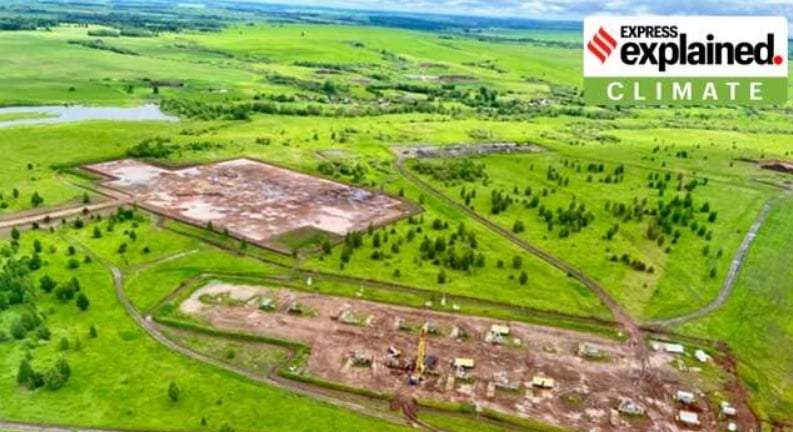What’s in today’s article?
- Why in news?
- What is carbon capture and storage?
- How well does CCS work?
- CCS: an economic problem than a technical one
- Why is CCS controversial?
- Way forward
Why in news?
- As per experts, carbon capture and storage is sorely needed to cut pollution in sectors where other clean technologies are farther behind.
What is carbon capture and storage?
- Carbon capture and storage (CCS) is a way to catch carbon and trap it beneath the earth.
- It is different to carbon dioxide removal (CDR) — where carbon is sucked out of the atmosphere.
- CDR brings down the level of carbon dioxide in the atmosphere, cooling the planet.
- On the other hand, CCS in fossil fuel plants and factories prevents the gas from getting out in the first place.
- Scientists see a big role for CCS in factories that make cement and fertiliser, as well as in plants that burn rubbish.
How well does CCS work?
- For many years, engineers have captured carbon from concentrated streams of gas — pushing it into tanks, scrubbing it clean and using it in industry or storing it underground.
- Some bioethanol plants, where the gas stream is pure, already report capturing more than 95% of the carbon emissions.
- But when it comes to capturing carbon from dirtier gas streams, like those from factories and power plants, CCS projects have repeatedly underdelivered.
- Some kind of chemical is needed to grab that CO2 from dirtier sources. Such technology has been successfully demonstrated.
- However, it has not been fully commercialised at scale.
- While a handful of test facilities have managed to capture more than 90% of emissions from some dirty gas streams, commercial projects have been plagued with problems.
CCS: an economic problem than a technical one
- Experts see the failures of CCS more as an economic problem than a technical one.
- They say companies have little incentive to capture their pollution. They contend that companies need to spend money and do the R&D until these technologies start working.
Why is CCS controversial?
- Uncertain effectiveness
- The technology does not seem to work as advertised. This is true especially in the case of dirty gas streams.
- There are concerns about the long-term storage capacity and stability of captured carbon dioxide, as well as potential leakage risks that could undermine the intended climate benefits.
- License to burn fossil fuels
- CCS also allows companies that want to continue burning fossil fuels to gain support from policymakers and a social license to continue their operations.
- Instead of using carbon capture as a climate solution, these companies use it to extract more oil by injecting carbon dioxide underground in a process called enhanced oil recovery.
- In the past, the primary use of captured carbon has been for this purpose of increasing oil production from depleted wells.
- Delays transition to renewable energy
- Critics argue that efforts and funding are being directed towards an expensive and unproven technology like CCS.
- This could delay the transition to a low-carbon future.
- Cost effectiveness
- CCS technology is expensive to develop, implement, and operate.
- The high costs associated with building and maintaining CCS facilities raise concerns about its economic viability, particularly when compared to other renewable energy options such as wind and solar power.
- Energy consumption:
- CCS requires a significant amount of energy to capture, transport, and store carbon dioxide.
- This energy requirement can reduce the overall efficiency of power plants and potentially increase their environmental impact.
Way forward
- In Norway, German industrial giant Heidelberg Materials is building the first facility to capture carbon from cement and store it underground.
- The company claims a capture rate of close to 100% is possible.
- To make the technology grow cheaper and work better, governments need to tax carbon, make it easier to approve CCS projects and help set up the infrastructure around it.
- There needs to be a subsidy for green steel and green cement, because that is really going to push the people who can accelerate the development of CCS.
Q1) What is renewable energy?
Renewable energy refers to energy sources that are naturally replenished and can be used continuously without being depleted. These energy sources are derived from natural processes that occur in the environment, such as sunlight, wind, water (hydro), biomass, and geothermal heat. Unlike fossil fuels, which are finite and contribute to environmental pollution and climate change, renewable energy is considered clean and sustainable, as it does not produce harmful emissions or greenhouse gases when harnessed. Renewable energy plays a vital role in mitigating climate change and achieving a transition to a more sustainable and low-carbon energy system.
Q2) What is carbon dioxide removal (CDR)?
Carbon Dioxide Removal (CDR), also known as negative emissions, refers to the process of actively removing carbon dioxide (CO2) from the atmosphere and storing it in various forms. CDR technologies and approaches aim to reduce the concentration of CO2 in the atmosphere, helping to mitigate climate change.
Source: Can we capture carbon and store it: Efforts, challenges
Last updated on December, 2025
→ Check out the latest UPSC Syllabus 2026 here.
→ Join Vajiram & Ravi’s Interview Guidance Programme for expert help to crack your final UPSC stage.
→ UPSC Mains Result 2025 is now out.
→ UPSC Notification 2026 is scheduled to be released on January 14, 2026.
→ UPSC Calendar 2026 is released on 15th May, 2025.
→ The UPSC Vacancy 2025 were released 1129, out of which 979 were for UPSC CSE and remaining 150 are for UPSC IFoS.
→ UPSC Prelims 2026 will be conducted on 24th May, 2026 & UPSC Mains 2026 will be conducted on 21st August 2026.
→ The UPSC Selection Process is of 3 stages-Prelims, Mains and Interview.
→ UPSC Result 2024 is released with latest UPSC Marksheet 2024. Check Now!
→ UPSC Prelims Result 2025 is out now for the CSE held on 25 May 2025.
→ UPSC Toppers List 2024 is released now. Shakti Dubey is UPSC AIR 1 2024 Topper.
→ UPSC Prelims Question Paper 2025 and Unofficial Prelims Answer Key 2025 are available now.
→ UPSC Mains Question Paper 2025 is out for Essay, GS 1, 2, 3 & GS 4.
→ UPSC Mains Indian Language Question Paper 2025 is now out.
→ UPSC Mains Optional Question Paper 2025 is now out.
→ Also check Best IAS Coaching in Delhi

















